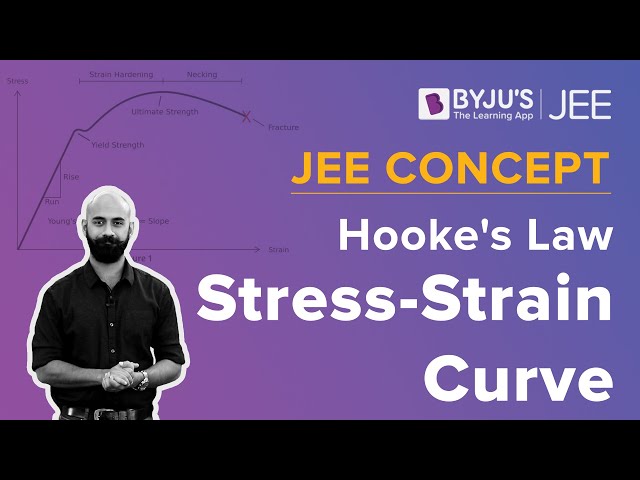You may have noticed that certain objects stretch easily, but stretching objects such as an iron rod sounds impossible, right? In this article, we will help you understand why a few objects are more malleable than others. Mainly, we will discuss Stress-Strain Curve because they help us know the amount of load or stress that a material can handle before it stretches and breaks.
|
Table of Contents |
What is Stress?
Stress is defined as force per unit area within materials that arise from externally applied forces, uneven heating, or permanent deformation and that permits an accurate description and prediction of elastic, plastic, and fluid behaviour.
Stress is given by the following formula:
\(\begin{array}{l}\sigma = \frac{F}{A}\end{array} \)
where,
The unit of stress is
Types of Stress
Stress applied to a material can be of two types as follows:
Tensile Stress
The deformation or elongation of a solid body due to applying a tensile force or stress is known as Tensile strain. In other words, tensile strain is produced when a body increases in length as applied forces try to stretch it.
Read More: Tensile Stress
Compressive Stress
Compressive strain is the deformation in a solid due to the application of compressive stress. In other words, compressive strain is produced when a body decreases in length when equal and opposite forces try to compress it.
Read More: Compressive Stress
What is Strain?
Strain is the amount of deformation experienced by the body in the direction of force applied, divided by the initial dimensions of the body.
The following equation gives the relation for deformation in terms of the length of a solid:
\(\begin{array}{l}\epsilon = \frac{\delta l}{L}\end{array} \)
where,
The strain is a dimensionless quantity as it just defines the relative change in shape.
Types of Strain
Strain experienced by a body can be of two types depending on stress application as follows:
Tensile Strain
Tensile strain is the change in length (or area) of a body due to the application of tensile stress.
Compressive Strain
Compressive Strain is the change in length (or area) of a body due to the application of compressive strain.
Stress-Strain Curve
When we study solids and their mechanical properties, information regarding their elastic properties is most important. We can learn about the elastic properties of materials by studying the stress-strain relationships, under different loads, in these materials.
The material’s stress-strain curve gives its stress-strain relationship. In a stress-strain curve, the stress and its corresponding strain values are plotted. An example of a stress-strain curve is given below.

Explaining Stress-Strain Graph
The different regions in the stress-strain diagram are:
(i) Proportional Limit
It is the region in the stress-strain curve that obeys Hooke’s Law. In this limit, the stress-strain ratio gives us a proportionality constant known as Young’s modulus. The point OA in the graph represents the proportional limit.
(ii) Elastic Limit
It is the point in the graph up to which the material returns to its original position when the load acting on it is completely removed. Beyond this limit, the material doesn’t return to its original position, and a plastic deformation starts to appear in it.
(iii) Yield Point
The yield point is defined as the point at which the material starts to deform plastically. After the yield point is passed, permanent plastic deformation occurs. There are two yield points (i) upper yield point (ii) lower yield point.
(iv) Ultimate Stress Point
It is a point that represents the maximum stress that a material can endure before failure. Beyond this point, failure occurs.
(v) Fracture or Breaking Point
It is the point in the stress-strain curve at which the failure of the material takes place.
Hooke’s Law
In the 19th-century, while studying springs and elasticity, English scientist Robert Hooke noticed that many materials exhibited a similar property when the stress-strain relationship was studied. There was a linear region where the force required to stretch the material was proportional to the extension of the material, known as Hooke’s Law.
Hooke’s Law states that the strain of the material is proportional to the applied stress within the elastic limit of that material.
Mathematically, Hooke’s law is commonly expressed as:
F = –k.x
Where F is the force, x is the extension length, and k is the constant of proportionality known as spring constant in N/m.
Read More: Hooke’s Law
See the video below to learn about the stress-strain curve and Hooke’s law.

Elastic Moduli of Materials
The following table lists the Young’s modulus, shear modulus and bulk modulus for common materials.
| Material | Young’s modulus (E) in GPa | Shear modulus (G) in GPa | Bulk modulus (K) in GPA |
| Glass | 55 | 23 | 37 |
| Steel | 200 | 84 | 160 |
| Iron | 91 | 70 | 100 |
| Lead | 16 | 5.6 | 7.7 |
| Aluminium | 70 | 24 | 70 |
Note: GPa is gigapascal and 1 GPa = 1,00,00,00,000 Pa.
| Related Reading |
Frequently Asked Questions – FAQs
What does the stress-strain curve show?
What is the use of the stress-strain diagram?
What is the relation between stress and strain?
What is yield point in stress-strain graph?
How to make a stress-strain curve?
Stay tuned to BYJU’S and Fall in Love with Learning!




Thank you. It is clear, simple and easy to understand
Strees and strain difference
Learn about the difference between stress and strain here.